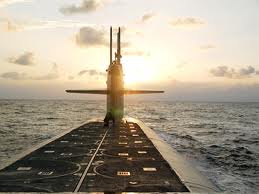In December 2013, the Congressional Budget Office released an authoritative estimate of how much the United States will spend over the next decade to maintain and upgrade its nuclear arsenal: $355 billion—for an average of $35 billion per year.
This covers nuclear weapons themselves; their delivery systems; nuclear weapons research and development; and nuclear command, control, communications, and early-warning systems. (For comparison, the budget deal President Obama just signed will increase federal spending by $63 billion over the next two fiscal years—for an average of $32 billion per year.)

A nuclear-armed submarine, with its missile launch tubes visible.
And then the money will really start flowing. The $355 billion is just the down-payment on what will be even larger expenditures over the following two decades. During that time the United States plans to build new delivery systems for these weapons: a fleet of 12 new nuclear-armed submarines, as well as new land-based missiles, long-range bombers, and cruise missiles. Delivery systems are more expensive than the warheads themselves. For example, estimates place the cost of these submarines at over $7 billion each.
What do we get for all this money? Massive overkill and outdated weapons. The U.S. nuclear arsenal includes over 4,600 weapons—with roughly 2,150 deployed and another 2,500 in reserve. (Another 3,000 exist, but are in storage awaiting dismantlement). Each is enough to devastate a city. It is simply irrational to maintain an arsenal of this size. And these weapons do nothing to address today’s security threats, including the threat of terrorism.
Tremendous savings are available if the United States reduces its arsenal to be commensurate with its stated policy of reducing the role of nuclear weapons in its security policy.
As Richard Garwin and I argued in an op-ed last year, the United States could easily cut its arsenal to a total of 1,000 nuclear weapons—including deployed and stored, long-range and short-range—while maintaining an effective deterrent. Taking this modest step would save hundreds of billions of dollars over the next several decades. And by helping to move the world to lower numbers of nuclear weapons, it will make us safer to boot.
